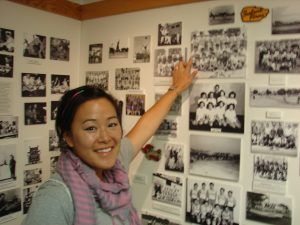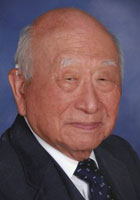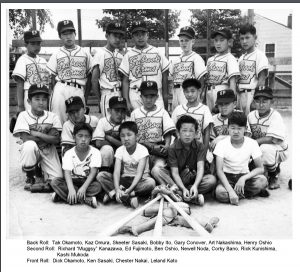July 14-16, 2017 to include the Obon Festival on July 15. SECC and the Seabrook Japanese American Citizens League (JACL) are co-sponsoring the inaugural John Fuyuume Citizen Award Luncheon in conjunction with the Seabrook Reunion. For Details and to volunteer contact SECC at (856) 451-8393 or Michael Asada, JACL President at 248 979 4828 michael.k.asada@gmail.com. As plans are finalized they will be posted. Registration will open in mid-February.
The tentative schedule, at this time, includes Friday registration/mixer at the headquarters hotel (below) beginning at 4 p.m. On Saturday there will be personal time with excursion options followed by a luncheon, tour of Seabrook Educational and Cultural Center and the Seabrook Obon Festival. Sunday begins with personal time followed by the Inaugural John Fuyuume Citizens Award Luncheon.
RESERVE HOTEL
Headquarters hotel is Ramada Inn, 2216 W. Landis Ave., Vineland, (856) 696-3800 Rate per night $119.+tax. Reserve online: http://www.wyndhamhotels.com/ramada/vineland-new-jersey/ramada-vineland. Group Code: SEABROOK REUNION. Reservation deadline June 14, 2017. Each room will be given a $5.00 voucher for the New IHOP collocated with the hotel for each day of your stay.
Alternate local hotels include:
Hampton Inn in Vineland, 2134 W. Landis Ave., Vineland, (856) 405-0600 Rate per night $139.+tax
Fairfield Inn & Suites in Millville, 301 Bluebird Lane, Millville, (856) 776-2400, Rate $149.+tax.

 John N. Fuyuume, 91, of Shannondell in Audubon, PA and formerly of Upper Deerfield Twp., NJ died Friday evening, September 30, 2016 suddenly and unexpectedly.
John N. Fuyuume, 91, of Shannondell in Audubon, PA and formerly of Upper Deerfield Twp., NJ died Friday evening, September 30, 2016 suddenly and unexpectedly.
John was born in Los Angeles, CA on April 24, 1925 and was the son of the late Junji and Chise (nee Takaoki) Fuyuume. At the age of 16, John and his family were incarcerated in the Gila River War Relocation Authority in Gila, AZ until his family was given the opportunity to relocate to Seabrook, New Jersey to work for Charles F. Seabrook and Seabrook Farms.
John went on to earn a Bachelor’s Degree in Music from the Eastman School of Music and a Master’s Degree in Music from the University of Rochester, NY. He graduated with highest honors. He also studied industrial engineering, accounting and computers.
On April 24, 1965, he married Setsuko “Sets” Hada at the Deerfield Presbyterian Church in Deerfield Street, NJ.
For several years John worked for International Utilities at various locations as their controller. His job duties then took him to Hamilton, Bermuda where he was Vice President of Gotaas-Larsen Shipping Corporation.
In 1990 they retired and returned to the Bridgeton, NJ area where John worked tirelessly to establish the Seabrook Educational and Cultural Center (SECC). The Fuyuumes created the Setsuko and John Fuyuume Piano Endowment Fund for the Eastman School of Music in Rochester, NY where he served on their Board of Managers. He also served on Board of Governors of the Japanese American National Museum in Los Angeles, CA, the Cumberland County Tourism Advisory Council and the Upper Deerfield Township Historical Commission. He was also served as president of the Bay Atlantic Symphony in Bridgeton and was a past-president and former treasurer of the Seabrook Chapter – Japanese American Citizens.
His final years were spent with his wife of nearly 50 years at Shannondell in Audubon, PA.
This past spring, John received two special honors: He was recognized in March by the Bridgeton Main Street Association as “Legend” in the greater Bridgeton community and in April was chosen to throw out the ceremonial first pitch at a Phillies game honoring Asian Pacific Celebration Night at Citizens Bank Park.
John is survived by two sisters-in-law, Eiko Ikeda (Bunji) and Chiz Sakata and, all of Shannondell, one brother-in-law, Kazuaki Hada (Jackie) of AZ and several nieces and nephews. In addition to his parents, he was predeceased by his wife, Setsuko, in 2015, a brother, Robert S. Fuyuume, in 1978 and a sister-in-law, Miyoko Wong in 2015.
Relatives and friends are invited to attend the funeral service at the Deerfield Presbyterian Church, Old Deerfield Pike in Upper Deerfield Township on Friday afternoon, October 14th at 1 o’clock where friends will be received at the church from 11:30 to 1.
The burial will follow in the church cemetery.
In lieu of flowers, memorial contributions are requested to Seabrook Educational and Cultural Center, 1325 Highway 77, Seabrook, NJ 08302, to the Deerfield Presbyterian Church, PO Box 69, Deerfield Street, NJ 08313 or to the Seabrook Chapter JACL, c/o Sharon Yoshida, 4 Mallard Dr., Bridgeton, NJ 08302.
Funeral arrangements are under the direction of Freitag Funeral Home, Bridgeton, NJ.
I was only three when we arrived in Seabrook in 1945. It was a great place for us kids to grow up. We had the nursery school playground behind our apartment. We played marbles there…remember “knuckles-down” and “no fudging?” Playing marbles was our earliest introduction to gambling because whatever you won, you got to keep. When we started going to school, we had more grown-up games to play like “jin-tori” (a version of capture-the-flag), “kick-the-can,” “over, over Red Rover,” “sink-the-battleship,” “chicken fight,” “splits” played with a pen-knife, “Estonian dodge-ball.” We didn’t start playing baseball, basketball and football until we were around 8 years old.
I remember Mr. Dick Kunishima (Rick and Randy’s father) taught us the game of baseball. He was a tough coach but he taught us well. Many of the more talented guys became really good ballplayers due to his coaching. We played basketball on the school ground and football on the front lawn of Seabrook School when we could. Mr. Miller, the school’s head custodian, would always chase us off the front lawn and threaten to call the police. When we didn’t see his pickup truck parked by the school, we would play football. As we played, we would keep an eye out for his pickup coming down Highway 77. When someone saw it we would all scatter. He never did catch any of us but he sure messed up many of our games.
 I remember when a new Japanese-American kid our age came to Seabrook around 1953. We were having a sandlot baseball game on the school ground and this new kid stood over on the first base side with his baseball glove and cap on, just standing there and watching. After a while one of the guys asked if he wanted to play, and he said yes. He was placed on the team that was short a player or two. Man, were we surprised that he could actually play baseball. He knew the rules. He could catch the ball. He could throw the ball. So, this new kid was quickly accepted by all of us. Looking back I can see how brave this little kid was to approach all of us who he didn’t know. baseball teamWe asked what his name was and where he came from and all of that. He said his name was Richard Kanazawa. He soon became a fixture in all of our games. It didn’t hurt that he could play pretty well, too. He also had a glove because at that time many of us had to exchange gloves each half-inning because we did not have gloves of our own. We started calling him “Muggsy” but I don’t know where that came from or who first started calling him that. That name stuck with him, at least with the Seabrook guys. To us he will always be Muggsy.
I remember when a new Japanese-American kid our age came to Seabrook around 1953. We were having a sandlot baseball game on the school ground and this new kid stood over on the first base side with his baseball glove and cap on, just standing there and watching. After a while one of the guys asked if he wanted to play, and he said yes. He was placed on the team that was short a player or two. Man, were we surprised that he could actually play baseball. He knew the rules. He could catch the ball. He could throw the ball. So, this new kid was quickly accepted by all of us. Looking back I can see how brave this little kid was to approach all of us who he didn’t know. baseball teamWe asked what his name was and where he came from and all of that. He said his name was Richard Kanazawa. He soon became a fixture in all of our games. It didn’t hurt that he could play pretty well, too. He also had a glove because at that time many of us had to exchange gloves each half-inning because we did not have gloves of our own. We started calling him “Muggsy” but I don’t know where that came from or who first started calling him that. That name stuck with him, at least with the Seabrook guys. To us he will always be Muggsy.
— M. Ken Sasaki, BHS Class of 1960, resident 1945-1966
As I think back to the good old days, more questions come to mind than anything … how did our large families live in such small accommodations…what family was the largest living in one apartment..?
How did the German displaced families move out of the community into their own homes so quickly?Who was Ms. Kajikawa … was she in the ministry? Was she part of some religious organization? Who else passed out the “Glad Tidings” to the various parts of the village for door-to-door distribution? Where did the people who helped with our summer Christian youth group come from and where did they stay?
When we arrived in Seabrook in 1950, we were given an apartment in prefabricated barracks in an area called “Hoover Village.” We were totally shocked at the sight of our new quarters, set closely together on sandy ground, without a single tree in the area. It was incredible that we would have the same type of accommodations as we did in the Displaced Persons camp in Germany. However, there was nothing we could do at the moment. A promise was made to move us to an apartment in one of their dormitory-type cinder-block buildings, as soon as one became available. In the meantime, we had to do with our two-room apartment, a combined kitchen-living room with an ice box, for which ice was delivered every couple of weeks, and a bedroom for my mother, brother and me.
Since we arrived in the spring season, my mother had to go to work at the factory almost immediately. She had never worked in a factory before, but she valiantly put on her blue uniform with a white collar and a white cap and rushed off with a cheerful smile. The work was grueling, each shift lasting 12 hours, with one day off every two weeks, but my mother, together with the other Estonian and Japanese women, did their jobs cheerfully. Their job was to sort vegetables on processing lines, peas, lima beans, strawberries, spinach, corn, etc. For some reason they had to stand up while doing this, hour after hour, while listening to music piped in and waiting for each hour to pass. Night shifts were worse for it was tough to stay awake. Workers had to clock in and out when they arrived and left, even when they went for lunch or the bathroom.
Since school year was in progress, I was placed in the Sophmore class at Bridgeton High School, and my brother in the Seabrook elementary school. It was a struggle at first since my knowledge of English was far from perfect. My first class was in Social Studies, where I faced a strict-looking teacher by the name of Miss Moody. Even though she was holding my application form stating that I was from Estonia, she announced: “Class, this is a new student whose name is Kyra. She comes from Indonesia.” I was too shy and scared to correct her. On the other hand, some other teachers were very nice. For instance, my English teacher, Miss Waugh, inspired my love for English literature for the rest of my life, and Miss Cossaboon made learning Latin less painful.
There were two other Estonian girls in my class, so we tended to keep together and did not socialize much with the others. The gal sitting next to me was Japanese, named Hisako, who was very friendly and helpful to me with homework. All of the Japanese students were brilliant and excelled in every subject. Some of my Estonian girlfriends developed a crush for Japanese boys since they looked so exotic and mysterious. The main object of interest was a boy called Tosh, who was class president, very handsome and smart. We used to look at him a lot, but none of us had the courage to talk to him. One day the Japanese students who lived in the same Seabrook housing development invited us to the cultural center to help them plan a party. This was a new experience. We did not have a clue what to do. They were discussing ideas about decorating the hall for the party and asked us for suggestions. Of course, we had none, since we had never done this before. They probably thought we were somewhat dumb, but America was still a culture shock and we had much to learn.
At the end of the school year, we had to find summer jobs. Since we were not yet 16, we could not get permits to work at the plant. However, the plant administration offered us jobs to work on the fields, picking beans. So, at 6 AM a truck drove us to the fields where we spent the whole day in the hot sun, squatting among bean bushes filling baskets as fast as we could. There was a weighing station in the middle of the field, manned by Japanese teenage boys who weighed our baskets and gave us receipts for the beans we picked. That was exciting, since the boys kidded around with us while we giggled. So the summer passed, a mixture of fun and exhaustion, for at the end of each day our backs and legs ached from squatting down and carrying heavy baskets. We also got badly sunburned, so we learned to wear hats and longsleeved shirts.
In the winter, work stopped at the plant and we had time to do other things. My mother and I joined a choral group that was organized by Mrs. Miido, one of our talented musicians, and I joined a folk dance group. Mr. Seabrook seemed to take interest in our activities and invited us to his New Year’s Eve party to entertain his guests with our performances. After our performances, we were allowed to mingle with his guests, eat his gourmet food and drink his champagne. One New Year’s Eve, one of Mr. Seabrook’s sons had brought to the party Eva Gabor, sister of Zaza, whom he was dating at the time. We tried to press close to her to admire her beauty, encased in an exquisite silver dress that barely covered her chest.
In 1953, after graduationg from high school, I moved to New York to attend another school, then get a job and get married. Fifty years later, there was an anniversary gala for all the former employees of Seabrook. One of the speakers was a lovely Japanese lady, who said at the end: “Once we lived here together, the Estonians with blond hair and blue eyes and the Japanese with black hair and brown eyes. Now we are together again and we all have white hair.” Seabrook will always stay in my memory as my first home in this country.
–Kyra Palango Aronson, BHS Class of 1953
In this newsletter John Fuyuume is Honored by Greater Bridgeton Legends and the Philadelphia Phillies
The Seabrook Educational and Cultural Center has announced the launch of its new website. The website features upcoming events, news and information, and many images showing the history of the center.